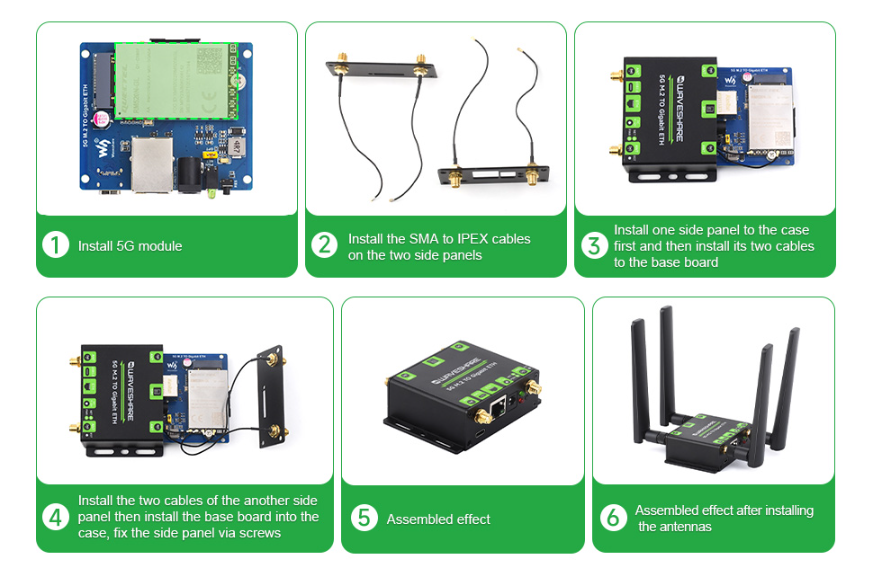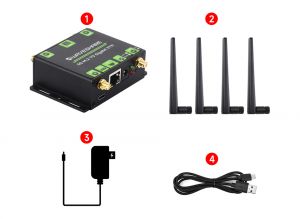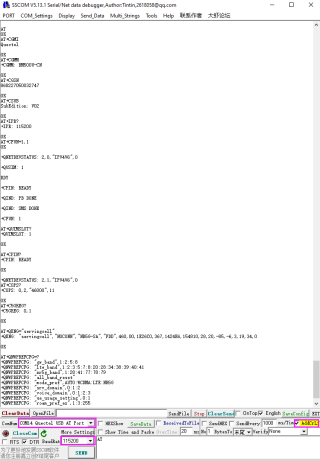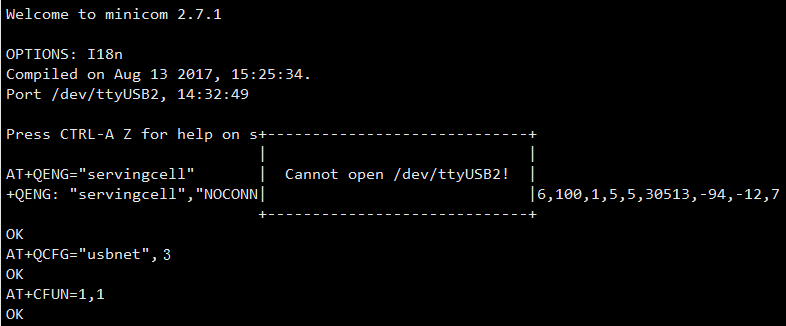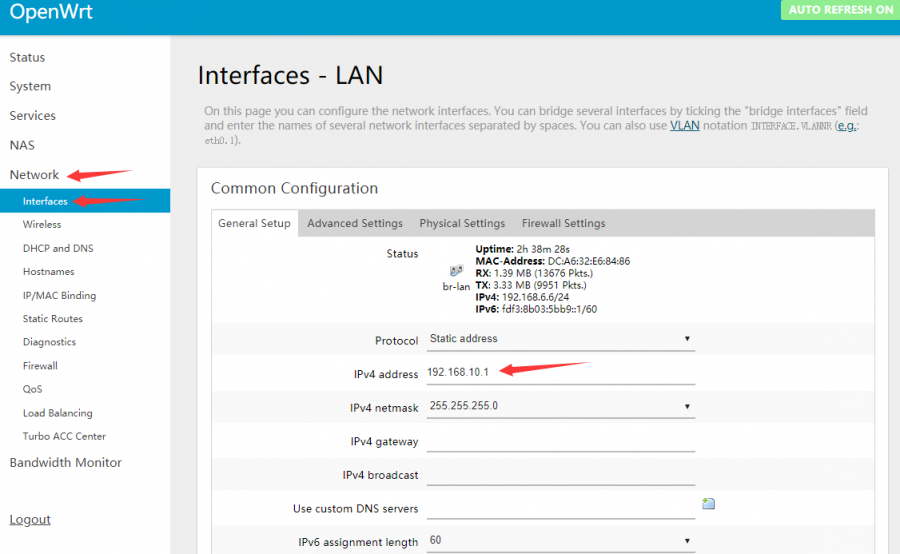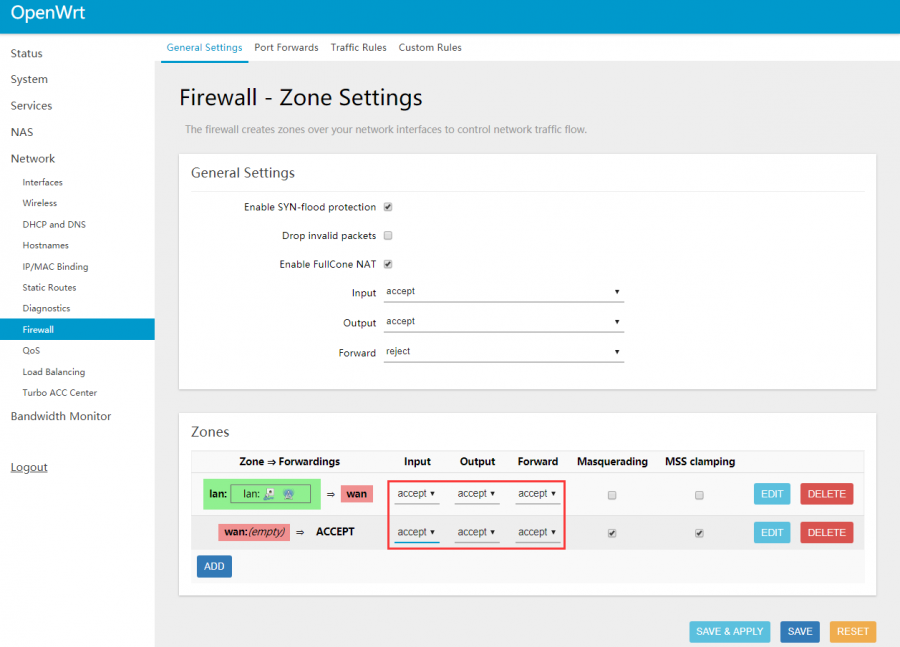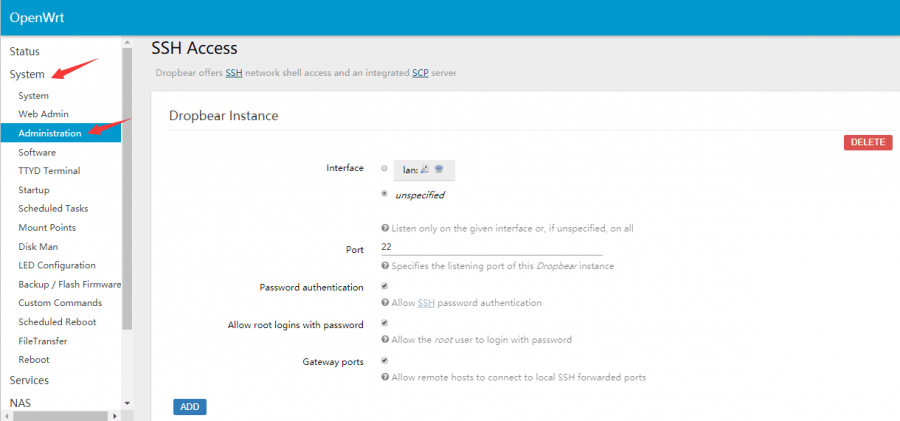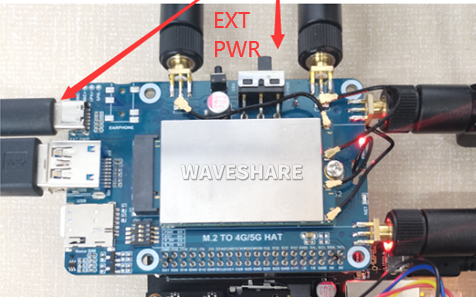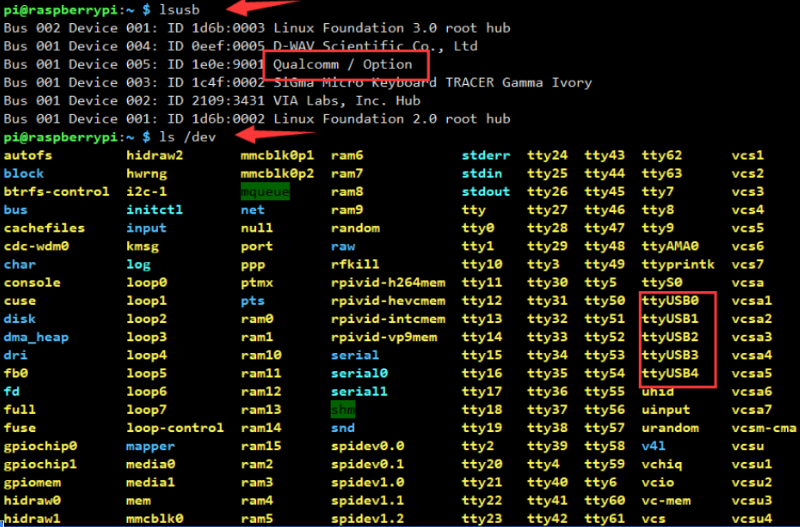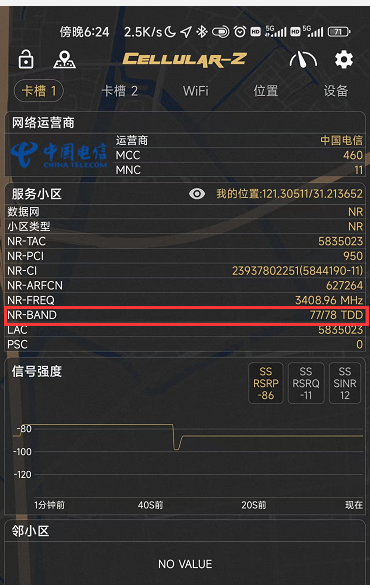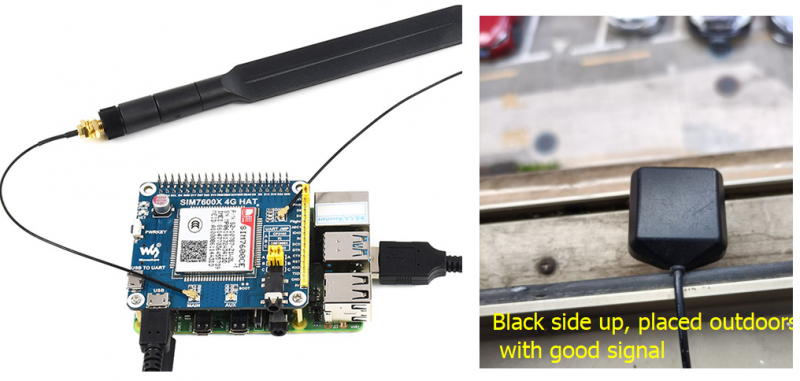5G M.2 TO Gigabit ETH
| ||
Overview
Features
- Supports 5G modules with M.2 (NGFF) Key B interface, compatible with mainstream 5G modules from brands such as SIMCom, Quectel, and Fibocom.
- Supports 5G modules in 3042/3052 packages such as SIM82XX, RM5XX, and FM160XX series.
- Onboard RTL8125 Ethernet chip, supports 5G to Gigabit Ethernet for high-speed 5G networking via the Gigabit Ethernet port.
- Onboard USB 3.1 Type-A port for connecting to PC, Raspberry Pi, or Jetson series motherboards for high-speed 5G networking or debugging.
- Onboard voltage translator circuit, supports 9-12V power supply via DC 5.5mm jack, or 5V/2A power supply via USB 3.1 port.
- Onboard standard SIM card slot.
- Onboard power supply and network indicator, reset button, for checking the working status of the module and 5G debugging.
- Aluminum alloy enclosure with oxidation dull-polish surface, CNC process opening, solid and durable, desktop or wall-mount support.
- Comes with 4× 5G omnidirectional high-gain antennas and a 12V power supply adapter, easy to use directly with a 5G module.
Hardware Description
Interface Introduction
5G Module Compatibility
Adaptable to most SIMCom/Mobile/KWT 5G M.2 interface modules, compatible with 3042 and 3052 packages.
The following table only lists some of the models supported by the actual test; if used for other models, the pin compatibility is subject to the actual test.
| Model | SIM8202G-M2 | SIM8262E-M2 | SIM8262A-M2 | RM500U-CNV | RM502Q-AE | RM520N-GL | FM160-EAU |
|---|---|---|---|---|---|---|---|
| 5G Standard | 3GPP R15 | 3GPP R16 | 3GPP R15 | 3GPP R16 | |||
| Applicable Regions | except Americas | Americas | China, EMEA, Asia-Pacific | Global (except China) | Global | EMEA, Australia | |
| Chip | Qualcomm Snapdragon X55 | Qualcomm Snapdragon X62 | UNISOC | Qualcomm Snapdragon X55 | Qualcomm Snapdragon X62 | ||
| Frequency Band | |||||||
| Sub-6G | n1, n2, n3, n5, n7, n8, n12, n20, n28, n38, n40, n41, n66, n71, n77, n78, n79 | n1, n3, n5, n7, n8, n20, n28, n38, n40, n41, n77, n78, n79 | n2, n5, n7, n12, n13, n14, n25, n30, n41, n48, n66, n71, n77, n78, n79 | 5G NR NSA:n41, n78, n79 | 5G NR NSA:n1, n2, n3, n5, n7, n8, n12, n20, n25, n28, n38, n40, n41, n48, n66, n71, n77, n78, n79 | 5G NR NSA:n1, n2, n3, n5, n7, n8, n12, n13, n14, n18, n20, n25, n26, n28, n29, n30, n38, n40, n41, n48, n66, n70, n71, n75, n76, n77, n78, n79 | n1, n3, n5, n7, n8, n20, n28, n38, n40, n41, n75, n77, n78 |
| 5G NR SA: n1, n2, n3, n5, n8, n28, n41, n77, n78, n79 | 5G NR SA: n1, n2, n3, n5, n7, n8, n12, n20, n25, n28, n38, n40, n41, n48, n66, n71, n77, n78, n79 | 5G NR SA: n1, n2, n3, n5, n7, n8, n12, n13, n14, n18, n20, n25, n26, n28, n29, n30, n38, n40, n41, n48, n66, n70, n71, n75, n76, n77, n78, n79 | |||||
| LTE-FDD | B1, B2, B3, B4, B5, B7, B8, B12, B13, B14, B17, B18, B19, B20, B25, B26, B28, B29, B30, B32, B66, B71 | B1, B3, B5, B7, B8, B18, B19, B20, B26, B28, B32 | B2, B4, B5, B7, B12, B13, B14, B25, B26, B29, B30, B66, B71 | B1, B3, B5, B8 | B1, B2, B3, B4, B5, B7, B8, B12, B13, B14, B17, B18, B19, B20, B25, B26, B28, B29, B30, B32, B66, B71 | B1, B3, B5, B7, B8, B20, B28, B32 | |
| LTE-TDD | B34, B38, B39, B40, B41, B42, B43, B48 | B38, B39, B40, B41, B42, B43 | B41, B46, B48 | B34, B38, B39, B40, B41 | B38, B40, B42, B43 | ||
| LAA | - | B46 | - | ||||
| WCDMA | B1, B2, B3, B4, B5, B8 | B1, B5, B8 | B2, B4, B5 | B1, B5, B8 | B1, B2, B3, B4, B5, B6, B8, B19 | B1, B2, B4, B5, B8, B19 | B1, B5, B8 |
| GNSS | GPS / GLONASS / BeiDou(Compass) / Galileo / QZSS(RM500Q-GL and RM502Q-AE do not support) | ||||||
| Data Rate | |||||||
| Sub-6G | 2.4Gbps (DL) / 500Mbps (UL) | 5G NR SA: 2Gbps (DL) / 1Gbps (UL) |
5G NR SA: 4.2Gbps (DL) / 450Mbps (UL) |
5G NR SA: 2.4Gbps (DL) / 900Mbps (UL) | |||
| 5G NR NSA: 2.5Gbps (DL) / 575Mbps (UL) |
5G NR NSA: 5.0Gbps (DL) / 650Mbps (UL) |
5G NR NSA: 3.4Gbps (DL) / 550Mbps (UL) | |||||
| LTE | 1.0Gbps (DL) / 200Mbps (UL) | 600Mbps (DL) / 150Mbps (UL) | 2.0Gbps (DL) / 200Mbps (UL) | 1.6Gbps (DL) / 200Mbps (UL) | |||
| UMTS | 42Mbps (DL) / 5.76Mbps (UL) | ||||||
| Dimensions | 42.0 × 30.0 × 2.3mm | 52.0 × 30.0 × 2.3mm | |||||
| Note: 5G module is optonal. This table only lists some supported models after actual testing, and the pin compatibility should be tested if used with other models. | |||||||
5G Module Installation Instruction
Operation Modes
Multiple operation modes are supported when the 5G M.2 TO Gigabit ETH works with 5G modules.
USB3.1 Port Direct Connection Mode
Enabling 5G High-Speed Networking For PC / Raspberry Pi /Jetson Series / Industrial Control Host Via USB 3.1 Port.

Gigabit Ethernet Port Direct Connection Mode
Enabling 5G High-Speed Networking For PC / Raspberry Pi /Jetson Series / Industrial Control Host Via Gigabit Ethernet Port.

Router Mode
The Router Accesses The 5G Network Via a Gigabit Ethernet Port, And Then Distributes To All Devices Connected to the 5G Networking.

USB 3.1 Port And Gigabit Ethernet Port Simultaneous Networking Mode
Provides 5G Network For Two Devices Separately Via USB3.1 Port And Gigabit Ethernet Port.
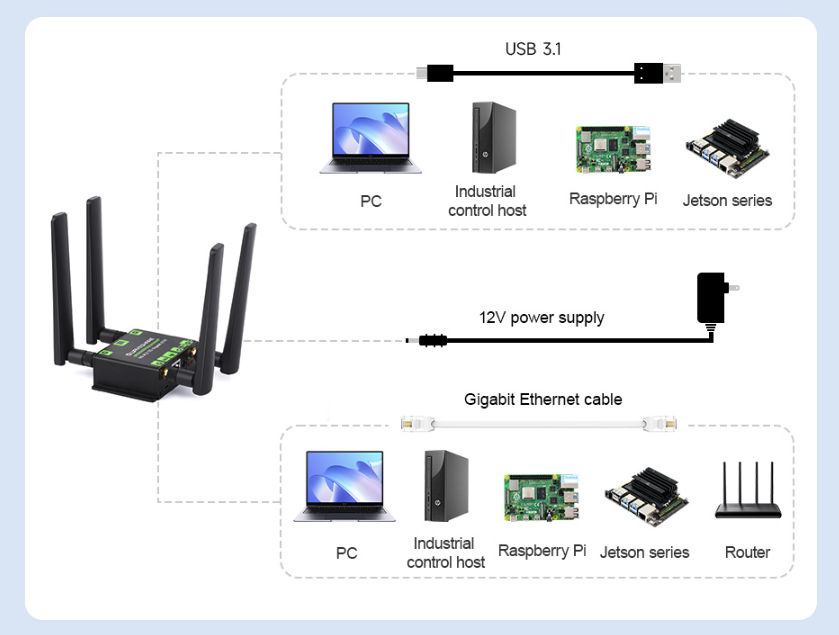
Test Preparation
Before using 5G M.2 TO Gigabit ETH for networking, you need to prepare the following materials and refer to the hardware connection below.
Materials Preparation
- 5G M.2 TO Gigabit ETH × 1 (The product and the included accessories as shown below):
- Compatible 5G module x 1 (NOT included, the compatible table as shown below.)
- 5G card x 1 (NOT included, enable 5G networking and the applicable 5G frequency band is supported by both the module and the local operator.)
- Network cable x 1 (NOT included)
- Host x 1 (NOT included, the host should come with a USB 3.0 interface and Ethernet port, Windows or Linux system, and support PC, tablet, Raspberry Pi, Jetson Nano, and industrial control host.)
Hardware Connection
- Install 5G M.2 TO Gigabit ETH as shown in #5G Module Installation Instruction, insert the 5G card and install the 5G antenna. Connect the module to the 12V DC power, and then connect it to the computer through a USB cable and network cable. The hardware connection as shown below:
5G Networking Description
The actual test of the 5G module of SIMCom, Quectel, and Fibocom is shown in the table below:
| 5G Modules | Usage | ||||||
|---|---|---|---|---|---|---|---|
| Vendor | Module Model | PC (Windows) | Raspberry Pi (Raspbian) | Jetson host (Ubuntu) | Indicator | USB3.1 | Gigabit Ethernet Port |
| Quectel | |||||||
| RM500U-CNV | Driver required | After networking, indicators such as NET are always on | Directly connect to the 5G network through the USB and Ethernet port at the same time by default | ||||
| RM500Q-GL | Driver required | Driver free | Directly access to the network through a USB connector by default, while AT commands should be set as Ethernet port mode for 5G network through the Ethernet port, and the USB connector and the Ethernet port should not be used at the same time | ||||
| RM502Q-AE | |||||||
| RM520N-GL | |||||||
| RM530N-GL | |||||||
| SIMCom | |||||||
| SIM8200EA-M2 | Driver required | After networking, NET indicator blinks | Dial-up required for USB connector | Directly networking through the Ethernet Port directly | |||
| SIM8202G-M2 | |||||||
| SIM8262E-M2 | Driver required | Driver free | Can use USB and Ethernet ports to connect to the 5G network by default. | ||||
| SIM8262A-M2 | |||||||
| Fibocom | FM160-EAU | ||||||
Connect to Quectel RM5XX Series Modules
Compatible with Quectel RM5XX Series Modules
The current compatible Quectel RM5XX series 5G modules tested as shown below:
Selection Guide
| 5G Sub-6 | RM500U-CNV | RM500Q-GL 5G HAT | RM502Q-AE 5G HAT | RM520N-GL | RM530N-GL | |
|---|---|---|---|---|---|---|
| Picture | 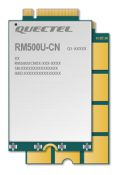
|

|

|

|

| |
| 5G Standard | 3GPP R15 | 3GPP R16 | ||||
| 5G Chip | UNISOC | Qualcomm | ||||
| 5G | Sub-6 GHz | Sub-6 GHz & mmWave | ||||
| Region/Operator | China, EMEA, Asia-Pacific | except Americas | except China | Global | ||
| Operating Temperature | -30°C ~ +75°C | |||||
| Extension Temperature | -40°C ~ +85°C | |||||
| Module Size | 30.0 × 52.0 × 2.3 (mm) | |||||
| Module Weight | 8.8g | 8.7g | 8.8g | |||
| Power Supply | 3.3~4.4V, Typ. 3.7V | 3.135~4.4V, Typ. 3.7V | ||||
| Power Consumption | 78μA @ shutdown; 5.1mA @ hibernate; |
70μA @ shutdown; 4.0mA @ hibernate; |
80μA @ shutdown; 4.2mA @ hibernate; |
195μA @ shutdown; 4.7mA @ hibernate; |
173μA @ shutdown; 5.1mA @ hibernate; | |
| Frequency Band | ||||||
| 5G | 5G NR | - | n257, n258, n260, n261 | |||
| 5G NR NSA | n41, n78, n79 | n41, n77, n78, n79 | n1, n2, n3, n5, n7, n8, n12, n20, n25, n28, n38, n40, n41, n48, n66, n71, n77, n78, n79 | n1, n2, n3, n5, n7, n8, n12, n13, n14, n18, n20, n25, n26, n28, n29, n30, n38, n40, n41, n48, n66, n70, n71, n75, n76, n77, n78, n79 | ||
| 5G NR SA | n1, n2, n3, n5, n8, n28, n41, n77, n78, n79 | n1, n2, n3, n5, n7, n8, n12, n20, n25, n28, n38, n40, n41, n48, n66, n71, n77, n78, n79 | n1, n2, n3, n5, n7, n8, n12, n13, n14, n18, n20, n25, n26, n28, n29, n30, n38, n40, n41, n48, n66, n70, n71, n75, n76, n77, n78, n79 | |||
| LTE | LTE-FDD | B1, B3, B5, B8 | B1, B2, B3, B4, B5, B7, B8, B12, B13, B14, B17, B18, B19, B20, B25, B26, B28, B29, B30, B32, B66, B71 | |||
| LTE-TDD | B34, B38, B39, B40, B41 | B34, B38, B39, B40, B41, B42, B43, B48 | ||||
| LAA | - | B46 | ||||
| UMTS | WCDMA | B1, B5, B8 | B1, B2, B3, B4, B5, B6, B8, B19 | B1, B2, B4, B5, B8, B19 | ||
| GNSS | - | GPS / GLONASS / BeiDou(Compass) / Galileo / QZSS (only RM520N-GL and RM530N-GL support) | ||||
| Data Rate | ||||||
| 5G mmWave | - | DL 4.0Gbps; UL 1.4Gbps | ||||
| 5G SA Sub-6 | DL 2Gbps; UL 1Gbps |
DL 2.1Gbps; UL 900Mbps |
DL 4.2Gbps; UL 450Mbps |
DL 2.4Gbps; UL 900Mbps | ||
| 5G NSA Sub-6 | DL 2.2Gbps; UL 575Mbps |
DL 2.5Gbps; UL 600/650Mbps |
DL 5Gbps; UL 650Mbps |
DL 3.4Gbps; UL 550Mbps | ||
| LTE | DL 600Mbps; UL 150Mbps |
DL 1.0Gbps; UL 200Mbps |
DL 2Gbps; UL 200Mbps |
DL 1.6Gbps; UL 200Mbps | ||
| UMTS | DL 42.2Mbps; UL 11Mbps |
DL 42Mbps; UL 5.76Mbps | ||||
Test Description
Common AT Commands
| Command | Description | Return Value |
|---|---|---|
| AT | AT test command | OK |
| ATE | ATE1 sets echo ATE0 turns off echo |
OK |
| AT+CGMI | Query module manufacture | OK |
| AT+CGMM | Query module model | OK |
| AT+CGSN | Query product serial number | OK |
| AT+CSUB | Query module version and chip | OK |
| AT+CGMR | Query the firmware version serial number | OK |
| AT+IPR? | Set the module hardware serial port baud rate | +IPREX: OK |
| AT+CFUN=1,1 | Reset module | OK |
| AT+QUIMSLOT? | Query SIM card selection: Return 1, select SIM card 1; Return 2, select SIM card 2 |
+QUIMSLOT: 1/2 OK |
| AT+CPIN? | Query the status of the SIM card and return READY, indicating that the SIM card can be recognized normally | +CPIN: READY |
| AT+COPS? | Query the current operator, the operator information will be returned after normal networking | +COPS: OK |
| AT+C5GREG? | Query 5G network registration status | +C5GREG: OK |
| AT+QENG="servingcell" | Query UE system information | |
| AT+QNWPREFCFG="mode_pref",AUTO | Auto Network Mode | OK |
Windows
Install Driver
- After connecting the 5G HAT to the computer through a double-ended USB3.0 data cable, there will be a series of devices without drivers installed on other devices:
- Enter the RM500U_Driver directory.
- Click setup.exe to install the driver. After the installation is complete, the device manager will generate the following devices:
Network Speed Test
- Install speed testing software, such as Internet speed manager and other speed testing software, you can choose to download the speed test at www.speedtest.cn/pc/download.
About the speed testing
As there will be many inconsistencies between actual and laboratory conditions that will result in 5G speeds that are not ideally stable at 100MBPS, there are the following.
- Base station distance, the closer to the 5G base station the better the signal and the faster the speed.
- Base station load, the fewer people using it the faster it will be, and the slower it will be during peak commuting periods.
- Number of base stations: due to the spectrum, an equal amount of 4G coverage requires double the number of 5G base stations.
- Operator: you need to confirm your 5G card, and whether the speed is limited, you can regularly ask the operator to reset your network.
- Indoor is worse than outdoor: building penetration attenuation, and indoor bypass attenuation.
PS: The current number of base stations still does not have good coverage, and the speed measurement is not quite the same in different locations.
Work with Raspberry Pi
Hardware Connection
Connect the 5G M.2 TO Gigabit Eth to the Raspberry Pi through a USB 3.0 cable.
ECM
Step 1. Uninstall modemmanager and network-manager
sudo apt purge modemmanager -y sudo apt purge network-manager -y
Step 2. Test 5G Module
- Ensure that the usb-serial driver option is correctly loaded onto the module interface. Use
usb-devicesto check:
pi@raspberrypi:~ $ usb-devices T: Bus=02 Lev=01 Prnt=01 Port=00 Cnt=01 Dev#= 3 Spd=5000 MxCh= 0 D: Ver= 3.20 Cls=00(>ifc) Sub =00 Prot=00 MxPS= 9 #Cfgs= 1 P: Vendor=2c7c ProdID=0800 Rev=04.14 S: Manufacturer= Quectel S: Product=RM502Q-AE S: SerialNumber=377628d2 C: #Ifs= 5 Cfg#= 1 Atr=a0 MxPwr=896mA I: If#=0x0 Alt= 0 #EPs= 2 Cls=ff(vend.) Sub=ff Prot=30 Driver=option I: If#=0x1 Alt= 0 #EPs= 3 Cls= ff(vend.) Sub=00 Prot=00 Driver=option I: If#=0x2 Alt= 0 #EPs= 3 Cls=ff(vend.) Sub=00 Prot=00 Driver=option I: If#=0x3 Alt = 0 #EPs= 3 Cls=ff(vend.) Sub=00 Prot=00 Driver=option I: If#=0x4 Alt= 0 #EPs= 3 Cls=ff(vend.) Sub=ff Prot=ff Driver= qmi_wwan
- Execute
ls /dev/ttyUSB*to view whether ttyUSB0~ttyUSB4 are correctly identified: - minicom tests the transmission of AT commands:
sudo apt-get install minicom sudo minicom - D /dev/ttyUSB2
Welcome to minicom 2.7.1 OPTIONS: I18n Compiled on Aug 13 2017, 15:25:34. Port /dev/ttyUSB2 Press CTRL-A Z for help on special keys AT OK
Step 3. Use AT Command For Network Setting
AT+QCFG="usbnet",1 AT+CGDCONT=1,"IPV4V6","YOUR_APN" AT+CFUN=1,1
Wait for the modem to restart. This may take up to 30 seconds. Once the modem reboots, minicom will be activated again.
After rebooting, open a new Linux terminal and use the 'ifconfig' or 'ip addr' command to check the 'usbX' in the network interfaces.

- After the module restarts and the NET indicator is on, use the following command to check the network status (optional).
AT+QENG="servingcell"
- Use the following commands to obtain IP and set DNS:
sudo dhclient -v usb0 sudo apt-get install udhcpc sudo udhcpc -i usb0 sudo route add -net 0.0.0.0 usb0
Step 4. Test 5G Network
After dialing, the Raspberry Pi can use the following command to see if usb0 has obtained an IP. Enter the command ifconfig usb0 or ifconfig.
pi@raspberrypi:~ $ ifconfig usb0
usb0: flags=4163<UP,BROADCAST,RUNNING,MULTICAST> mtu 1500
inet 192.168.225.60 netmask 255.255.255.0 broadcast 192.168.225.255
inet6 fe80::8543:f6a0:e678:2e20 prefixlen 64 scopeid 0x20
ether 4a:aa:f8:62:36:bb txqueuelen 1000 (Ethernet)
RX packets 73 bytes 5047 (4.9 KiB)
RX errors 0 dropped 0 overruns 0 frame 0
TX packets 100 bytes 15116 (14.7 KiB)
TX errors 0 dropped 0 overruns 0 carrier 0 collisions 0
ping waveshare.com -I usb0
pi@raspberrypi:~ $ ping waveshare.com -I usb0 PING waveshare.com (104.26.11.134) from 192.168.10.27 usb0: 56(84) bytes of data. 64 bytes from 104.26.11.134 (104.26.11.134): icmp_seq=1 ttl=52 time=87 ms 64 bytes from 104.26.11.134 (104.26.11.134): icmp_seq=2 ttl=52 time=82 ms 64 bytes from 104.26.11.134 (104.26.11.134): icmp_seq=3 ttl=52 time=92 ms 64 bytes from 104.26.11.134 (104.26.11.134): icmp_seq=4 ttl=52 time=73 ms 64 bytes from 104.26.11.134 (104.26.11.134): icmp_seq=5 ttl=52 time=75 ms
5G Network Speed Test
In the Linux system, you can test it by installing speedtest_cli:
## Raspberry Pi OS sudo apt install speedtest-cli speedtest # or use speedtest_cli
or
## OpenWRT opkg update opkg install python3 opkg install python3-pip pip install speedtest_cli speedtest # or use speedtest_cli
Troubleshooting
Check whether the module recognizes the SIM card:
AT+CPIN? # should return READY
Check whether the module registers the network:
AT+CEREG? # should return 0,1 or 0,5
Check whether the APN is correct and has the IP:
AT+CGCONTRDP # should return APN details and IP address
Working with Jetson Nano
Hardware Connection
Connect USB TO M.2 B KEY to the Jetson Nano through a double-head USB 3.0 cable.
RM5XX Module Configuration
Generally, the latest system can be directly operated without a driver after connecting the RM5XX module to the Jetson Nano. If the Linux kernel is too old to recognize the module, you can refer to the following # 【Load USB Device Descriptors】 content to drive the module before 5G networking.
【Load USB Device Descriptors】
In order to identify the module, the VID and PID information of the module needs to be added to the file [Kernel].
- Viewing the VID and PID of the RM500U:
lsusb
- Add VID and PID.
sudo apt-get install unzip wget https://files.waveshare.com/upload/0/09/RM5XXQ_For_Jetson_nano.zip unzip RM5XXQ_For_Jetson_nano.zip sudo chmod 777 -R RM5XXQ_For_Jetson_nano cd RM5XXQ_For_Jetson_nano sudo ./install.sh sudo reboot
Please refrain from deleting or modifying the 'option' directory, 'default.script', 'install.sh', and these four files, as it may affect the loading of device descriptors.
- After successfully adding IP and restarting Jetson Nano, input the following commands, and then display USB0-USB4 five device descriptors.
ls /dev/ttyUSB*
RNDIS Dial Networking
- Enter minicom:
sudo apt-get install minicom sudo minicom -D /dev/ttyUSB2
- Send the following commands for RNDIS dial networking in minicom:
AT+CPIN? AT+QCFG="usbnet",3 AT+CFUN=1,1
- After resetting the module, the NET indicator is on, and you can use the following commands to check the network status (optional).
AT+QENG="servingcell"
- Use the following commands to get IP and set DNS:
sudo dhclient -v usb1 sudo apt-get install udhcpc sudo udhcpc -i usb1 sudo route add -net 0.0.0.0 usb1
- After dialing, you can see that USB1 gets the IP by the following command:
ip route
ping -I usb1 www.baidu.com
Connect to the Ethernet Port
Qualcomm
RM500Q-GL, RM502Q-AE, RM520N-GL, and RM530N-GL modules are 5G modules with Qualcomm solution. For this solution, switching the network port to access the Internet, you need to command the following AT commands to set up.
1. Enable RTL8125:
AT+QCFG="data_interface",1,0 //NIC switched to pcie mode AT+QCFG="pcie/mode",1 //Switch pcie to RC mode AT+QETH="eth_driver","r8125" //Switch the NIC driver to realtake 8125
2. Reset the module:
AT+CFUN=1,1
3. Setup will be USB RNDIS mode:
AT+QCFG="usbnet",2
Or
AT+QCFG="usbnet",3
Spreadtrum
The RM500U-CN and RM500U-CNV are based on Spreadtrum solutions. Normally, no settings are required upon factory default, allowing simultaneous internet access through both the USB and network ports. If the USB port enables internet access while the network port doesn't, you can execute the following AT command for configuration.
AT+QCFG="pcie/mode",1 AT+QCFG="ethernet",1 AT+QNETDEVCTL=1,1,1
Working With SIM82XX Module
Parameter
| SIM8200EA-M2 | SIM8202G-M2 | SIM8262E-M2 | SIM8262A-M2 | |
|---|---|---|---|---|
| 5G Standard | 3GPP R15 | 3GPP R16 | ||
| Chip | Qualcomm Snapdragon X55 | Qualcomm Snapdragon X62 | ||
| Frequency Band | ||||
| Sub-6G | n1, n2, n3, n5, n7, n8, n12, n20, n28, n38, n40, n41, n48, n66, n71, n78 | n1, n2, n3, n5, n7, n8, n12, n20, n28, n38, n40, n41, n66, n71, n77, n78, n79 | n1, n3, n5, n7, n8, n20, n28, n38, n40, n41, n77, n78,n79 | n2, n5, n7, n12, n13, n14, n25, n30, n41, n48, n66, n71, n77, n78, n79 |
| LTE-FDD | B1, B2, B3, B4, B5, B7, B8, B12, B13, B14, B17, B18, B19, B20, B25, B26, B28, B29, B30, B32, B66, B71 | B1, B3, B5, B7, B8, B18, B19, B20, B26, B28, B32 | B2, B4, B5, B7, B12, B13, B14, B25, B26, B29, B30, B66, B71 | |
| LTE-TDD | B34, B38, B39, B40, B41, B42, B43, B48 | B38, B39, B40, B41, B42, B43 | B41, B46, B48 | |
| WCDMA | B1, B2, B3, B4, B5, B8 | B1, B5, B8 | B2, B4, B5 | |
| GNSS | GPS, GLONASS, Beidou, Galileo and QZSS | |||
| Data Rate | ||||
| Sub-6G | 2.4 Gbps (DL) / 500 Mbps (UL) | |||
| LTE | 1 Gbps (DL) / 200 Mbps (UL) | |||
| HSPA+ | 42 Mbps (DL) / 5.76 Mbps (UL) | |||
| Software Function | ||||
| Operating System | Windows/Linux/Android | |||
| Communication Protocol | TCP/IP, IPV4, IPV6, Multi-PDP, FTP, FTPS, HTTP, HTTPS, MQTTS, DNS, SSL3.0 | |||
| Dail Up | RNDIS, NDIS, PPP, MBIM | |||
| SMS | Support MT, MO, CB, Text, PDU | |||
| Firmware Upgrade | Supports firmware upgrade via USB port | |||
| Hardware Specification | ||||
| SIM Card | 1.8V/2.95V | |||
| Antenna | For 3G/4G/5G/GNSS | |||
| 6 × IPEX-4 Connectors | 4 × IPEX-4 Connectors | |||
| Power Supply | 3.135~4.4V | |||
| Form Factor | M.2 | |||
| Dimensions | 52.0 × 30.0 × 2.3mm | 42.0 × 30.0 × 2.3mm | ||
| Operating Temperature | -30℃ ~ +70℃ | |||
| Application Scenarios | ||||
| Region | China, US, Japan, and South Korea, Europe, the Middle East, the Americas | Other regions except for the Americas | Americas | |
| The applicable area is for reference only, and the appropriate module should be selected according to the frequency band covered and supported by the local operator's network. | ||||
| Typical Application | CPE, Smart Gateway, Drone, Live Video, Telemedicine, Smart Security | |||
Working with Windows PC
Install Driver
Download the SIM8200 Driver from the Resources part to your PC and unzip it.
Enter the SIM8200_OS_Driver\Windows directory.
Enter the 1_install directory and run the setup.exe file to install.

After connecting, a mobile network icon appears, and you can disconnect the other networks and test the mobile network.
Install Driver Manually
For most hosts, although 1_install is installed, there are no COM ports shown. In this case, you need to manually add the 2_AddManully file folder. Here is the way to add: find the unrecognized device in Device Manager, right-click to add the driver as shown below:
Power on the G module, switch it ON and the module boots, and then the PC will recognize four unrecognized devices (5 or 6 devices are recognized). Here the picture only shows 5 devices.
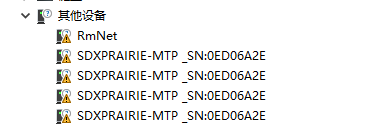
Right-click to update the driver demo, choose to add it manually, and select the path as SIM8200_OS_Driver\Windows. Please select it according to your system (WIN7\WIN8\WIN10), and there are up to 6 devices that can be selected, and then the PC will generate the following devices.

Four COM ports: AT is used for AT command control, Audio is used for dialing, Diagnostics is used for debugging, and NMEA is used for GPS.

![]()
A mobile network will be set up automatically after updating, you can disconnect other networks and test it.
Manual NDIS Dial-up Internet
After installing the driver, some computers cannot automatically dial up to access the Internet, so you need to dial manually, the operation is as follows:
Download SSCOM software, open the sim8200 AT port to send the following command:
AT$QCRMCALL=1,1 //carrier return required

At this point, NDIS dial-up is active, and the computer can connect to the network. If it returns "No Carrier", the dial-up may have already occurred. Try accessing the internet directly.
GPS Positioning
Connect the passive GPS antenna to the ANT5 of the module, and place the antenna outdoors facing the sky. Then send the AT command to turn on the GPS:
AT+CGPS=1
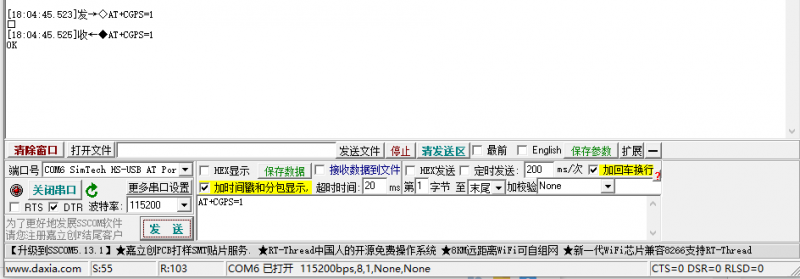
Now open the NEMA port, and you can get GPS data:
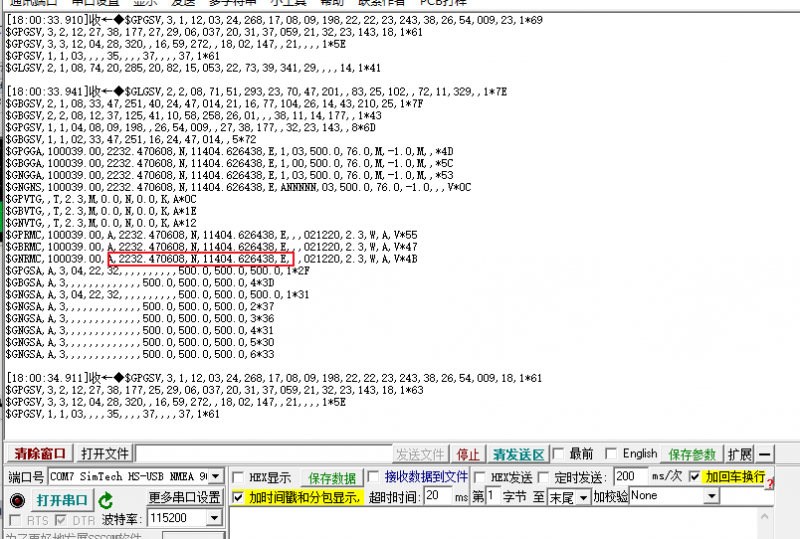
Finally, turn off the GPS, you can use the AT command:
AT+CGPS=0
SIM Card Config
- SIM card 1 is used by default, and you can use the following commands to switch to SIM1 when it is SIM2.
AT+SMSIMCFG=1,1
- Or you can directly switch to SIM2:
AT+SMSIMCFG=1,2
- If it still does not work, consider that the flight mode is on, and turn off the flight mode with the following command:
AT+CFUN=1
Working with Raspberry Pi
Configuration
This configuration is only required for the first time.
Open a terminal and run the following commands:
sudo apt-get install p7zip-full wget https://files.waveshare.com/upload/f/fb/SIM8200-M2_5G_HAT_code.7z 7z x SIM8200-M2_5G_HAT_code.7z sudo chmod 777 -R SIM8200-M2_5G_HAT_code cd SIM8200-M2_5G_HAT_code sudo ./install.sh
Please do not modify option, qmi_wwan_simcom, default.script,install.sh files or directorys, otherwise the dirver cannot be installed normally.
Run ifconfig -a command to check WWAN0 interface.

Testing with AT command
sudo apt-get install minicom sudo minicom -D /dev/ttyUSB2
5G Networking
cd Goonline make sudo ./simcom-cm
After running codes, DNS information are shown as figure below:

After connecting two SIM820X to Raspberry Pi through USB, two network cards—wwan0 and wwan1 can be recognized, and the two network cards can be dialed at the same time through the following commands: (The network speed cannot be superimposed)
sudo ./simcom-cm -i wwan0 sudo ./simcom-cm -i wwan1
- Note: If the IP cannot be obtained or the networking is not successful, use the following commands to obtain the IP and set the DNS networking:
sudo dhclient -v wwan0 sudo route add -net 0.0.0.0 wwan0
Auto-run
If you want to set the codes to auto-run after booting, you can modify rc.local file:
sudo nano /etc/rc.local
Add the line to file as below:
sudo /home/pi/SIM8200-M2_5G_HAT_code/Goonline/simcom-cm &
Note that you have to add "&" to the end of the command, make sure that the command can be run in the background, or the Pi may not boot normally.
Live Streaming With ffmpeg
If you are using the 2020-08-20-raspios-buster-armhf image, then you don't need to install anything as the system already comes with ffmpeg.
Going straight to the topic, assuming you already have a camera and it's properly connected to the Raspberry Pi, then proceed with the tutorial.
- The camera must be enabled by running the raspi-config command before using it:
sudo raspi-config Select Enable Camera, select YES
- If it is a camera using the CSI interface, the system cannot find the device node of /dev/video0. A line for bcm2835-v4l2 needs to be added to the /etc/modules file:
sudo nano /etc/modules
add:
bcm2835-v4l2

Then after the system starts, the system will load the module name in this file and restart the system:
sudo reboot ls /dev/video*
The video0 device node is found below.
![]()
Note: If after performing the first steps, please confirm that the operation and instructions are correct.
Suppose you are using Douyu Live now, register your account and enable the host function, open Douyu Live Host Center, and find the live broadcast settings.

Open video plug flow setting:

The rtmp address and live code will be obtained, and the Raspberry Pi will execute the command:
ffmpeg -f video4linux2 -s 640x480 -r 25 -i /dev/video0 -c:v h264_omx -f flv "rtmp address/live code"
For example: open a terminal first, runs the 5G network:
cd Goonline sudo ./simcom-cm
and then open another terminal, run the following command:
ffmpeg -f video4linux2 -s 640x480 -r 25 -i /dev/video0 -c:v h264_omx -f flv "rtmp://sendtc3.douyu.com/live/9188303rTNGmU7CS?wsSecret=ef762877aae120262eaf23c3f60a28bf&wsTime=5f59dbf0&wsSeek=off&wm=0&tw=0&roirecognition=0"
rtmp://sendtc3.douyu.com/live is the address, and the next section is the live code. Enter the room number at this time, you can observe the live broadcast, the delay is about 1-2S.
How To Use OpenWrt
Introduction
Soft routing is using desktops or servers and other equipment with software. It mainly depends on the settings of the software to achieve the functions of the router. The hard routing is a unique hardware device, including a processor, power supply, and embedded software to provide router functionality.
OpenWrt is a very popular soft routing system. It is a highly modular and highly automated embedded Linux system with powerful network components and scalability. It is often used in industrial control equipment, routers, and other equipment.
In addition to the functions of general home routers, OpenWrt soft routing can also achieve port forwarding, intranet penetration, 4G networking, FTP server and more powerful functions.
Program the Image
Download the RPI OpenWrt system, unzip the system in the Imgs directory, and use the burning tool to burn the system to the SD card.
Login & Initial Settings
- After the OpenWrt system is turned on, the Raspberry Pi is equivalent to a router. Therefore, you can use a network cable to connect the Raspberry Pi to the computer according to the use of the router (you can also use the mobile phone to search for WIFI, the default name is "OpenWrt"). Enter 192.168.1.1 on the webpage, the default username: root, the default password: password, and enter the Web management interface of OpenWrt.
- Set WIFI password: Network -> Wireless -> Modify -> Interface Configuration -> Wireless Security, as shown below:
- Create the new interface: Network -> Interface -> Create interface.
- Modify the IPv4 address of the LAN port to a different IP that is not the same as the LAN port IP of other routers in your home. (Many routers default the LAN port IP to 192.168.1.1. If you do not modify the IP of the OpenWrt, it will easily lead to conflicts and failure to connect to the Internet.)
- In addition, it is recommended to adjust the Firewall setting to connect the OpenWrt terminal and Web management interface through the local area.
- Network —>Firewall, change all "reject" to "accept", and click "Save & Apply" after modification, as shown in the picture below:
- And then select System -> Administration, modify the allowed interface for SSH access to "unspecified" (that is, any interface can be accessed by ssh), check the Gateway port, and click "Save & Apply" after the modification is completed.
- At this point, you can connect to the OpenWrt web management interface or terminal through the IP address of the LAN port or wan port.
Network Config
- Insert the SIM card into the card slot of the communication module -> connect all 5G antennas, connect to the Raspberry Pi 4B via USB -> power on;
- Change the mobile communication module to RNDIS mode (USB network sharing mode), SIM8202G can be changed by sending the following commands through minicom in Openwrt:
sudo minicom -D /dev/ttyUSB2 //(Some modules need to add PID to have ttyUSB* device character) at+cusbcfg=usbid,1e0e,9011 //(Different models of modules have different setting methods, see the module specification for details)
To switch back to NDIS mode (factory default mode) use this command:
at+cusbcfg=usbid,1e0e,9001
- Enter the Web management interface of OpenWrt, click Network —> Interface —> Add new interface
- Create new interface: name -> SIM8202G; protocol of new interface - DHCP client; include the following interfaces - ethernet adapter: "usb0", and then submit:
- Confirm that the interface selection in "Firewall Settings" is "wan"
- Wireless configuration: Network->Wireless Network->Interface->Basic Config->Network,check SIM8202G and lan, save and apply.
Then the other devices can be connected to the OpenWrt wireless "OpenWrt" or through the network cable to connect to OpenWrt's own network port for networking.
5G Network Speed Test
In terms of the speed measurement, as the Raspberry Pi comes with a Gigabit Ethernet port, and there are few USB network cards above Gigabit, we use the "SpeedTest For Python" tool to test the speed with the command.
Connect to the terminal of the OpenWrt, and enter the command one by one to test:
opkg update opkg install python3 opkg install python3-pip pip install speedtest_cli speedtest or speedtest_cli
Raspberry Pi minicom Serial Port Debugging
1. Insert the module into the Raspberry Pi and set the S_TX and S_RX of the dipswitch to ON.

2. Install minicom, minicom is the serial port debugging tool for Linux.
sudo apt-get install minicom
- Use minicom to open ttyUSB2:
sudo minicom -D /dev/ttyUSB2
Send to enable the UART serial port:
AT+CCUART=1
3. Open ttyS0 via minicom - ttyS0 is the serial port of the Raspberry Pi 3B/3B+/4B, and the default baud rate is 115200.
sudo minicom -D /dev/ttyS0
4. Raspberry Pi 2B/zero, the user serial device number is ttyAMA0; you can use the following command line to confirm that serial0 is the selected serial device number, as follows:
ls -l /dev/serial*
Work with Jetson Nano
It is recommended that you use the system image jetson-nano-sd-card-image (updated in October 2020). The Linux kernel version of this system is 4.9.140-tegra. The previous system is 4.4. This tutorial is based on the 4.9 kernels. If there is a difference, please update to the same version as this one, which will minimize the chance of your using it incorrectly.
If you are using other Linux systems, please download the driver under SIM8200_OS_Driver\linux and port it according to the documentation under it.
Configuration Required for First Use
- It's best to copy and paste in case you type the wrong letters:
sudo apt-get install p7zip-full wget https://files.waveshare.com/upload/0/07/Sim8200_for_jetsonnano.7z 7z x Sim8200_for_jetsonnano.7z -r -o./Sim8200_for_jetsonnano sudo chmod 777 -R Sim8200_for_jetsonnano cd Sim8200_for_jetsonnano sudo ./install.sh
Please do not delete or modify the "options", "qmi_wwan_simcom", "default.script", "install.sh" directory files, otherwise it will affect the loading of the driver.
If there is an error, please confirm whether the system kernel is 4.9.140-tegra, and take a screenshot of the error message so that engineers can help you analyze and solve the problem.
Run "ifconfig -a" to see that WWAN0 has been generated.

AT Test Command
sudo apt-get install minicom sudo minicom -D /dev/ttyUSB2
5G Network
cd Goonline make sudo ./simcom-cm
You can successfully see that DNS has been generated at the bottom.

Others
If you need to use the product on other systems, please download the SIM8200_OS_Driver file, and refer to the SIMCOM official documentation to add the driver.
About the Speed
Due to the differences between actual and laboratory conditions, the 5G speed will not be ideal and stable at 100MBPS. There are the following points:
- Base station distance, the closer to the 5G base station, the better the signal and the faster the speed.
- Base station load, the fewer people using it, the faster the speed will be, and the rush hour will be slower.
- Number of base stations: Due to spectrum relationships, the same amount of 4G coverage requires double the number of 5G base stations.
- Provider: You need to confirm whether your 5G card is limited in speed, you can periodically ask the provider to reset your network.
- Indoors is worse than outdoor: building penetration loss, and indoor diffraction loss.
- PS: The current number of base stations still does not have good coverage, and the speed measurement in different locations is not the same.
Using the Ethernet Port for Internet Access
The SIM8200EA-M2, SIM8202G-M2, SIM8262E-M2, and SIM8262A-M2 modules are 5G modules based on Qualcomm solutions by SIMCom. In this solution by SIMCom, the default network port allows direct internet access without the need for specific command settings.
Work with FM160-EAU Modules
Connect to Windows through USB
You need to install the GuangheTong 5G driver. Once the driver is installed, you can access the internet.
Connect to Raspberry Pi through USB
Driver-free by default, supports direct access to the Internet.
Connect to Jetson Nano
Driver-free by default, supports direct access to the Internet.
Connect to Ethernet Port
The FM160-EAU module is the Qualcomm Snapdragon 5G module and the Guanghetong module accesses to the network directly through the Ethernet port with command setting.
Resource
RM50XX
Demo
Software
Datasheet
SIM82XX & FM160-EAU
Demo
Software
Document
Related Application Cases
- RNDIS Dial-Up
- SIM820X 5G HAT is equipped with Raspbian Pi to open hotspots
- SIM820X PPP Dial-Up
- 5G/4G Raspberry 4B openWrt Sample Tutorial
- SIMXXX Locates My Location on Gaode Map
- SIM8200EA-M2 5G HAT for Raspberry Pi 5G Smart Mobile Robot GPS Function and Smartphone APP Position Service
FM160-EAU
Driver
Datasheets
FAQ
RM50XX FAQ
RM500U-CN: based on Spreadtrum.
RM500Q-GL: based on the Qualcomm platform, supports GNSS positioning, mainly for China.
RM500q-AE/RM502Q-AE: based on the Qualcomm platform, supports GNSS positioning, mainly for countries except China.
{{{5}}}
{{{5}}}
{{{5}}}
AT+QCFG="usbnet",0 driver type is NDIS(QMI)); AT+QCFG="usbnet",1 The driver type is ECM; AT+QCFG="usbnet",2 The driver type is MBIM; (RM5XXQ support) AT+QCFG="usbnet",3 The driver type is RNDIS AT+QCFG="usbnet",5 The driver type is NCM;
{{{5}}}
ATE1
{{{5}}}
SIM82XX FAQ
{{{5}}}
AT+CNBP? //(you can copy the band to notepad) backup band AT+CNBP=0x100600000FC00000,0x00000000000000460000A7E2BB0F38DF,0x0000000000000000,0x00000000003FFE63000681E2090828D7. 0x00000000003FFE63000681E2090828D7 //assign the band to SIM820X or AT+CNBP=0x100600000FC00000,0x0000000000000046000001E2000908DD,0x00000000000000000000,0x00000000000000007042000081A0080808D7. 0x00000000000070000000010000000000 //give the frequency band to SIM820X AT+CNMP=71 // Fixed 5G
{{{5}}}
It may be that the APN is not acquired, generally, the APN is able to be acquired automatically, some areas (IoT cards) need to be acquired manually, for example, can be set by the following instructions:
AT+CGDCONT=1, "IP", "APN" // different operators APN is different, here the APN is changed to the corresponding operator
You can check the APNs of major carriers at the following websites: APN Search Website

{{{5}}}
- The default is to use SIM card 1, it may be switched to SIM card 2, please use the following command to switch to SIM card 1:
AT+SMSIMCFG=1,1
- Or directly switch to SIM card 2:
AT+SMSIMCFG=1,2
- If it still doesn't work, consider that the airplane mode is turned on, and use the following command to turn off the airplane mode:
AT+CFUN=1
Question: What should I do if the SIM820X module NDIS dial fails and the driver cannot be installed?
- You can program the newest Raspbian system and reconfigure NDIS dial-up.
- Also, you can use the pre-configured image.
{{{5}}}
In this case, the network connection may not be successful. Follow the steps below to troubleshoot:
1. First confirm the hardware problem:
- Check whether the connected SIM card can communicate and surf the Internet normally on mobile phones and other devices:
- Check whether the antenna is connected properly;
- Check that the NET light is flashing, and it is always on, indicating that it is not registered to the network
2. After confirming that the hardware is OK, you can use the following command (AT LOG) to further confirm the network situation:
*Check the firmware version information: AT+SIMCOMATI *Check if the sim card is in good contact: AT+CPIN? *Turn the radio on (turn off airplane mode): AT+CFUN=1 *Check that the network mode is set to auto-seek: AT+CNMP=2 *Check the signal quality of the current environment: AT+CSQ *Check if the registration to the network is successful: AT+CGREG? *Check internet connection: AT+CPSI? *Check if the APN corresponds to the operator of the SIM card: AT+CGDCONT? *Check operator access: AT+COPS?
{{{5}}}
- After confirming that the SIM card is normal and the local 5G network is covered, follow the steps below to fix 5G (to increase the network speed).
AT+CNBP? //(Can copy the frequency band to Notepad) Backup frequency band AT+CNBP = 0x100600000FC00000, 0x000000000000000046004600001e2000908dd, 0x00000000000000000000000000000070420081a00808d7, 0x0000000000000000000000 // AT+CNMP=71 // Fixed 5G
- The 5G operator's SIM card frequency band should cover the SIM820X frequency band; sometimes the 4G network is queried, and the speed has reached 5G. You can directly measure the speed to confirm that the 5G network speed is available.
- To confirm whether the test environment has 5G network coverage, you can install Cellular-Z on a 5G mobile phone (all major app stores can download it) to view the detailed network information:
- Apple phones can follow the following steps to obtain band information:
- Open the phone dialer, enter *3001#12345#*, then click the dialer button.
- In the pop-up page, first, find and click "Serving Cell Info", then find and click "Freg Band Indicator.
- Check according to the table issued by the operator, and you will know.
{{{5}}}
- It is recommended to use the more convenient RNDIS dial-up.
- You can burn the latest Raspberry Pi Raspbian system and reconfigure the NDIS dial-up.
- Or you can use the image of the RNDIS dial-up with drivers already configured and boot the Raspbian system image (with drivers installed).
{{{5}}}
AT+CSYSSEL="nr5g_band",41:78
{{{5}}}
{{{5}}}
{{{5}}}
{{{5}}}
{{{5}}}
The following commands can be used to save the SMS to the module memory:
AT+CPMS="MT"
{{{5}}}
at+voltesetting=1 at+cnv=/nv/item_files/modem/mmode/ue_usage_setting,1,01,1
The VOLTE function can be turned off with the following command:
at+voltesetting=0 at+cnv=/nv/item_files/modem/mmode/ue_usage_setting,0,01,1
{{{5}}}
- Insert the GPS antenna into the GNSS antenna holder (SIM8200EA is ANT5; SIM8202G is ANT2), and place the receiver in the open outdoors (note that the test cannot be done in rainy weather), the power needs to wait for about 1 minute before the positioning signal is received;
- M2 module needs a passive antenna to obtain positioning information, if you do not have a passive positioning antenna, the matching 5G antenna is also available, replace the 5G antenna and put the module into outdoor positioning (the 5G antenna does not come with an extension cable)::
{{{5}}}
USB, Raspberry Pi runs "sudo. /install" will load the USB driver, and we connect communication with a 3B/4B USB connector. According to the tutorial, you can load the USB driver on Windows, and it will display as an unknown device when there is no driver.
{{{5}}}
{{{5}}}
{{{5}}}
After prolonged operation, the lubricating oil in the rolling bearing fan may evaporate, leading to increased noise. This is a common phenomenon with rolling bearing fans and does not indicate a malfunction of the fan.
{{{5}}}
We use the RTL8125 network port solution.
Theoretically, RTL8125 supports 2.5G, but it depends on the 5G module and the network condition of the test environment.
{{{5}}}
Support
Technical Support
If you need technical support or have any feedback/review, please click the Submit Now button to submit a ticket, Our support team will check and reply to you within 1 to 2 working days. Please be patient as we make every effort to help you to resolve the issue.
Working Time: 9 AM - 6 AM GMT+8 (Monday to Friday)


